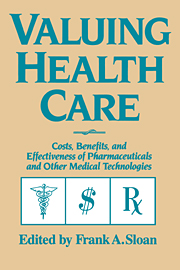 Valuing Health Care
Valuing Health Care Book contents
- Frontmatter
- Contents
- List of Tables
- List of Figures
- List of Boxes
- Acknowledgments
- 1 Introduction
- 2 Evidence of effectiveness: evaluating its quality
- 3 Utility assessment for estimating quality-adjusted life years
- 4 Measuring costs
- 5 From cost–effectiveness ratios to resource allocation: where to draw the line?
- 6 Valuing health care benefits in money terms
- 7 Discounting health effects for medical decisions
- 8 Statistical issues in cost–effectiveness analyses
- 9 Decision trees and Markov models in cost–effectiveness research
- 10 The use of cost–effectiveness/cost–benefit analysis in actual decision making: current status and prospects
- Notes
- References
- Index
5 - From cost–effectiveness ratios to resource allocation: where to draw the line?
Published online by Cambridge University Press: 07 December 2009
- Frontmatter
- Contents
- List of Tables
- List of Figures
- List of Boxes
- Acknowledgments
- 1 Introduction
- 2 Evidence of effectiveness: evaluating its quality
- 3 Utility assessment for estimating quality-adjusted life years
- 4 Measuring costs
- 5 From cost–effectiveness ratios to resource allocation: where to draw the line?
- 6 Valuing health care benefits in money terms
- 7 Discounting health effects for medical decisions
- 8 Statistical issues in cost–effectiveness analyses
- 9 Decision trees and Markov models in cost–effectiveness research
- 10 The use of cost–effectiveness/cost–benefit analysis in actual decision making: current status and prospects
- Notes
- References
- Index
Summary
In recent years, cost–effectiveness analysis has been the most prevalent type of economic evaluation of health care interventions, including pharmaceuticals (Torrance 1986; Eisenberg 1989; Detsky and Naglie 1990; Freund and Dittus 1992). Unlike cost–benefit analysis, which requires that health outcomes be valued in monetary units in order to calculate the net economic benefit of a program, cost–effectiveness analysis requires only that a quantitative measure of health effectiveness, or utility, be defined. Typically, effectiveness is measured by life years (LYs) or quality-adjusted life years (QALYs). The cost–effectiveness ratio (dollars per LY or dollars per QALY) serves as a yardstick for measuring the relative priority of health interventions that compete for limited resources.
Perhaps because it avoids translating health consequences into dollars, cost–effectiveness analysis has been more favorably received by the medical community than cost–benefit analysis and has been favored by government agencies that have proposed or adopted economic criteria for funding of health programs or paying for new drugs (Klevit et al. 1991; Henry 1992). Although economic valuation of health consequences is avoided in the analysis per se, the problem of deciding in absolute terms whether a program is worth funding or not rests on whether a particular value of the cost–effectiveness ratio (e.g., $100,000 per QALY) is acceptable.
Following a review of the theoretical framework that leads to the use of the cost–effectiveness ratio as a decision criterion, this chapter addresses three issues in interpreting cost–effectiveness ratios and in translating them into criteria for resource allocation.
- Type
- Chapter
- Information
- Valuing Health CareCosts, Benefits, and Effectiveness of Pharmaceuticals and Other Medical Technologies, pp. 77 - 98Publisher: Cambridge University PressPrint publication year: 1995
- 36
- Cited by


